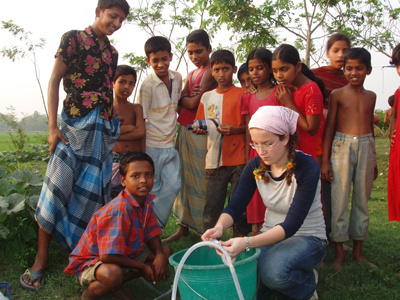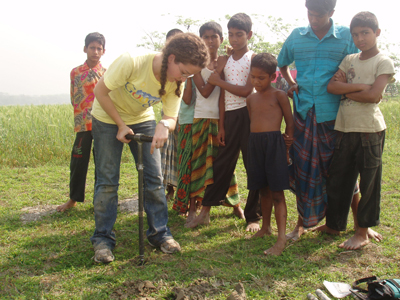
 |
|---|
| Rebecca sampling the water in Bangladesh |
Abstract
Soil air profiles from Araihazar, Bangladesh and the High Plains aquifer in Nebraska and Colorado show that at depth to the water table, noble gas and SF6 concentrations in soil air are not significantly changed by subsurface biological activity. CO2 production by root respiration and/or organic matter decay is balanced nearly completely by O2 consumption in the unsaturated zone. Maximum CO2 concentrations at the Bangladesh and High Plains sites were 11.63% and 4.82% respectively. Percent standard deviations across depth profiles for all Bangladesh sites were 1.12% for Neon, 1.28% for Argon, 2.63% for Krypton, and 2.96% for Xenon. These deviations in concentration were converted into deviations in calculated temperature using the expected temperature at the water table in Bangladesh, 26°C. The results deviated from 26°C by ±0.6-0.7°C, comparable to the analytical error of ±0.5°C inherent in measuring noble gases. Sulfur Hexafluoride (SF6) measurements in soil air deviated from mean measurements by ±0.12-0.13 ppt. These deviations were converted into minimum and maximum deviations in calculated groundwater (GW) age of ±0.66-0.71 years for GW from 1980, ±1.26-1.34 years for GW from 1990, and ±1.85-1.97 years for GW from the year 2000. These deviations are comparable to the measurement error of ±1-2 years inherent in measuring SF6 concentrations.
 |
|---|
| Rebecca uses an auger to collect a soil sample. |
Go to Science Research Projects.
Go to Learning Objectives of Research Project.
Return to E&ESJ home page.
Last updated: 8 January 2001, KAK.